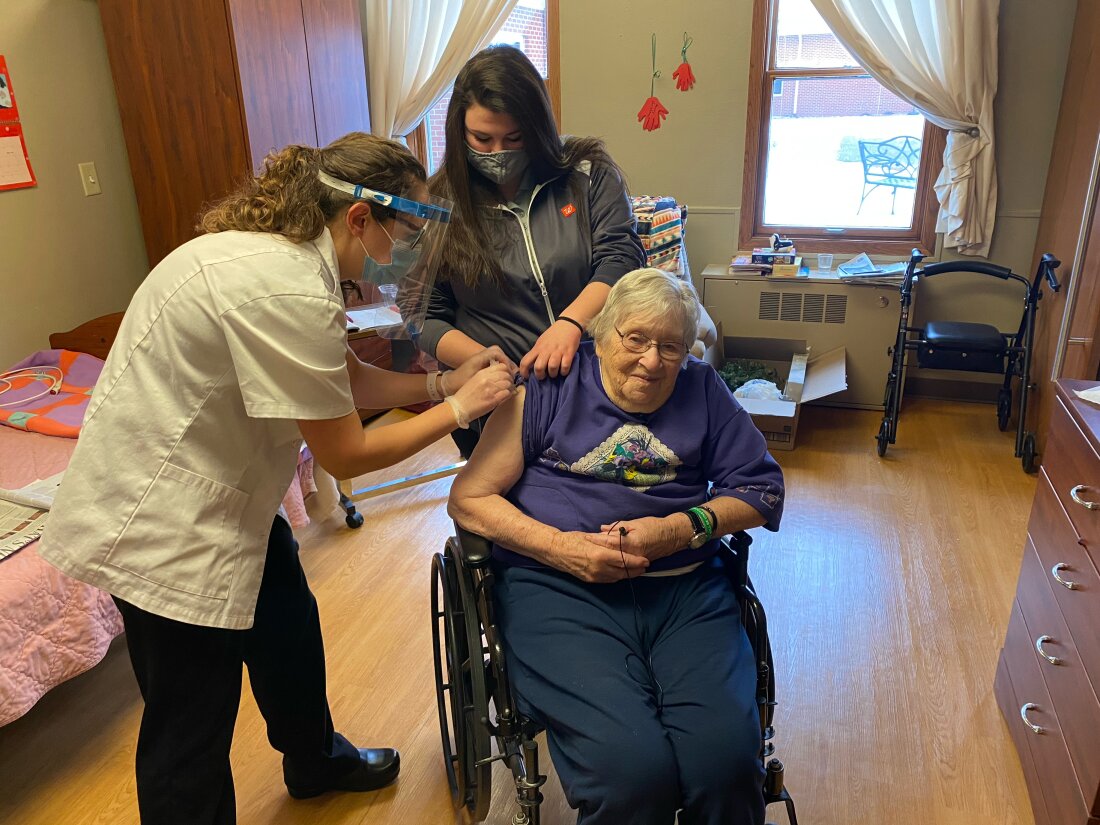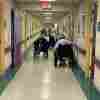
Mary Ann Herbst, a patient at the Good Samaritan Society nursing home in Le Mars, Iowa, receives her first COVID-19 vaccine shot on Dec. 29, 2020. A recent study found that only 4 in 10 nursing home residents in the United States have received at least one dose of the most recent COVID vaccine, released last fall.
Sanford Health
hide legend
toggle caption
Sanford Health
It seems like no one is taking COVID-19 seriously anymore, said Mollee Loveland, a nursing home aide who lives outside Pittsburgh.
Loveland has seen patients and nursing home colleagues die from the virus.
Now she has a new worry: bringing COVID home and unwittingly infecting her baby daughter, Maya, born in May.
“She’s still so little,” said Loveland, whose maternity leave ended in late June. Six months is the earliest a baby can be vaccinated against COVID.
Loveland is also concerned about the possibility that the nursing home will experience a summer surge of COVID, just like last year.
“It’s further amplified by respiratory problems because of the humidity, heat and dampness of the climate,” she said.
Between the complex medical needs of its patients and their close proximity to one another, COVID continues to pose a serious threat to the Loveland nursing home — and the 15,000 other certified nursing homes in the United States, where some 1.2 million people live.
Despite that risk, an April report found that only four in 10 nursing home residents in the United States have received the most recent COVID vaccine, released last fall. The analysis used data from Oct. 16, 2023, to Feb. 11, 2024, and was conducted by the Centers for Disease Control and Prevention
The CDC report also found that during the COVID peak in January, the rate of hospitalizations among nursing home residents was more than eight times higher than that of all U.S. adults aged 70 and older.
Billing Complexities and Patient Skepticism
The low vaccination rate is partly because the federal government no longer foots the bill for vaccines, said Dr. Rajeev Kumar, a Chicago-based geriatrician.
While the vaccine remains free for patients, doctors must now bill each person’s insurance company separately. That makes vaccinating an entire nursing home more logistically complicated, Kumar said.
Molly Loveland and her daughter Maya in a park in Washington, Pennsylvania. Loveland works at a nearby nursing home. She worries about catching COVID-19 and passing it to her baby after she returns to work. Federal data shows that only 4 in 10 nursing home residents in the United States have received at least one dose of the most recent COVID vaccine, released last fall.
Sarah Boden
hide legend
toggle caption
Sarah Boden
Kumar is president of the Society for Post-Acute and Long-Term Care Medicine, which represents clinicians who work in nursing homes and similar settings, such as post-acute care, assisted living facilities and hospices.
“The challenges of managing that process and organizing vaccinations, making sure that someone can bill for the services and collect the money, that’s what’s become a little more cumbersome,” he said.
(In April, after the study was published, the CDC recommended that adults 65 and older get an additional dose of the updated vaccine if it has been more than four months since their last shot. That means that going forward, most nursing home patients who got just one shot in the fall or winter won’t be considered up-to-date on their COVID vaccinations.)
Another problem is that Kumar and his colleagues are facing greater skepticism about the COVID vaccine than when it was first launched.

“The long-term care population is a microcosm of what is happening across the country and, unfortunately, there is still COVID-19 vaccine hesitancy in the general population. This is our biggest challenge,” according to an emailed statement from Dr. David Gifford, chief medical officer of AHCA/NCAL, which represents both for-profit and nonprofit nursing homes.
Nursing assistant Mollee Loveland has also observed doubt and misinformation among patients at her job: “It’s the Facebook rabbit hole.”
But there are ways to combat misinformation, and states show wide variation in the proportion of nursing home residents who have been recently vaccinated.
For example, in North and South Dakota, more than 60% of nursing home residents in those states have received at least one COVID shot since early October.
Building Trust Through Relationships
Sanford Health, one of the largest medical systems operating in the Dakotas, has managed more than two dozen nursing homes since its 2019 merger with long-term care chain Good Samaritan Society.
In some of these nursing homes, more than 70% of residents have been vaccinated since early October — at one Sanford facility in Canton, South Dakota, the rate is over 90%.
Sanford has managed to optimize the size of the health system to administer the vaccine more efficiently, said Dr. Jeremy Cauwels, Sanford’s chief medical officer. He also attributed that to a close collaboration with a South Dakota-based pharmacy chain, Lewis Drug.

But the most crucial factor is that many patients in Sanford’s nursing homes are treated by doctors who are also employed by the health system.
At the majority of Sanford nursing homes in North and South Dakota, these clinicians provide on-site primary care, meaning patients do not need to leave the facilities to see their doctor.
Another benefit of this integration is that Sanford’s clinicians and nursing home staff both have access to the same patient medical records, helping them track which patients have been vaccinated and which have not.
These employed physicians have played a critical role in persuading patients to stay up-to-date on their COVID vaccines, Cauwels said. For example, one medical director who worked at Good Samaritan nursing home in Canton was a longtime physician with strong ties to that community.
“A proper one-on-one conversation with someone who cares about you and has a history of doing this, for us, has resulted in much better numbers than other places have been able to get nationally,” said Cauwels, who added that Sanford still needs to work to reach the remaining patients who have not received the recent COVID vaccine.
Sanford’s success shows that the responsibility to vaccinate patients isn’t limited to nursing homes, said Jodi Eyigor, director of nursing home quality and policy for LeadingAge, which represents nonprofit nursing homes. She said primary care providers, hospitalists, pharmacists and others in the health care sector need to step up.
“What conversations were having before they walked through the doors of a nursing home, between them and their doctors? Because they probably see their doctors resign frequently before they walk into the nursing home,” said Eyigor, who notes that these other clinicians are also regulated by Medicare, the federal health insurance program for adults 65 and older.
Critics: Vaccine push linked to residents’ discontent
Nursing homes are still required to educate patients — as well as staff — about the importance of COVID vaccines. Industry critics argue that one-on-one conversations, based on trusted relationships with clinicians, are the minimum nursing homes should do.
But many facilities don’t even appear to be doing that, according to Richard Mollot, executive director of the Long Term Care Community Coalition, a watchdog group that monitors nursing homes. A recent vaccination rate of 40% is inexcusable, he said, given the danger the virus poses to people who live in nursing homes.
A study in the Journal of Health Economics estimates that from the start of the pandemic through August 15, 2021, 21% of COVID deaths in the United States were among people living in nursing homes.
Mollot says the critically low COVID-19 vaccination rate is actually a symptom of broader problems across the sector. He hears from patients’ families about poor food quality and a general apathy toward residents’ concerns in some nursing homes. He also cites high staff turnover rates and substandard, even dangerous, care.
These problems have intensified in the years since the COVID pandemic began, Mollot said, causing considerable stress across the industry.

“It’s led to a huge decrease in care, much more disrespectful interactions between residents and staff, and there’s just a lack of trust,” he added.
Mollee Loveland, the nursing assistant, also believes the industry has fundamental problems when it comes to the day-to-day interactions between workers and residents. She said managers in her job often ignore patients’ concerns.
“I feel like if institutions did more for patients, they would be more respected by patients,” she said.
So when administrators announce that it’s time for residents to get vaccinated against COVID-19, Loveland says, they’re often simply ignored, even though it puts their own health at risk.
This story is from NPR’s health reporting partnership with KFF Health News.